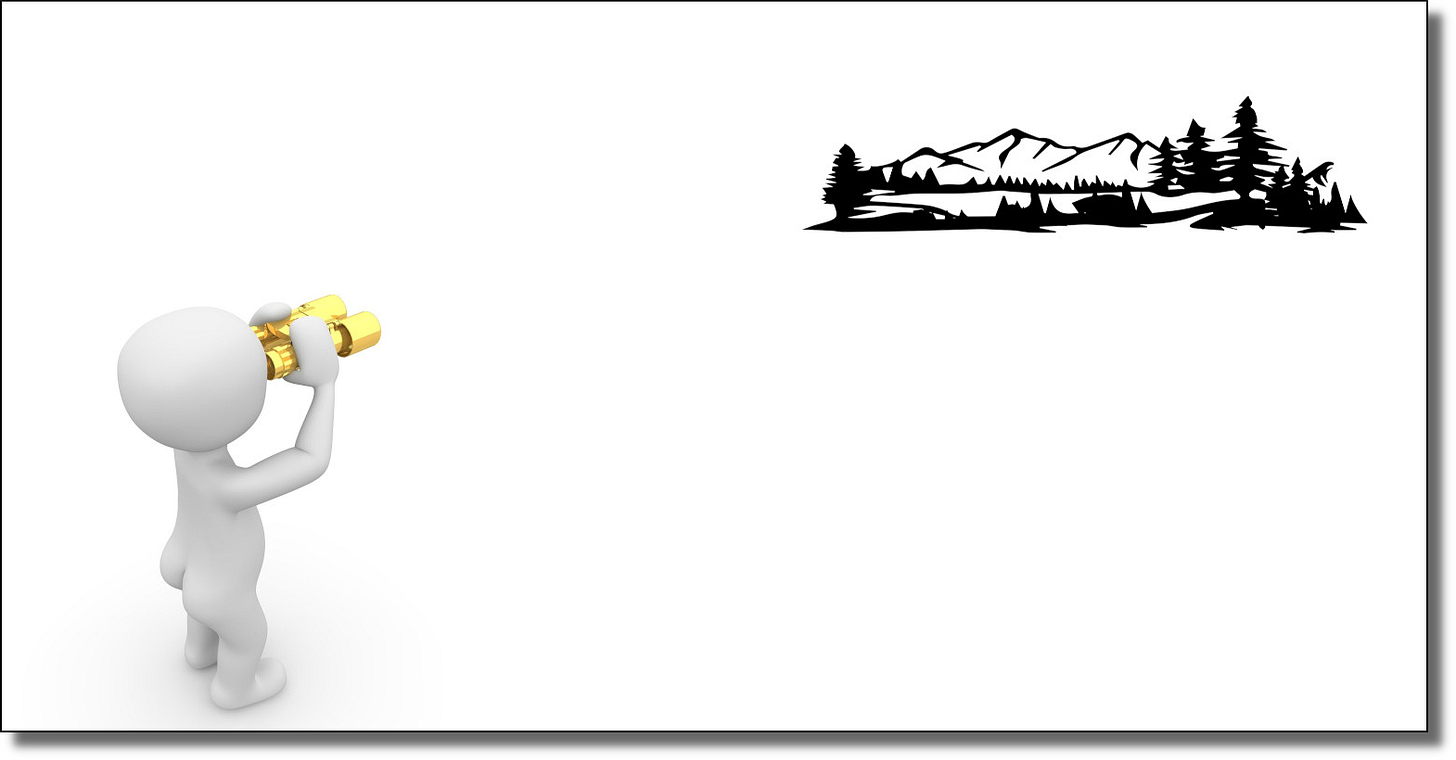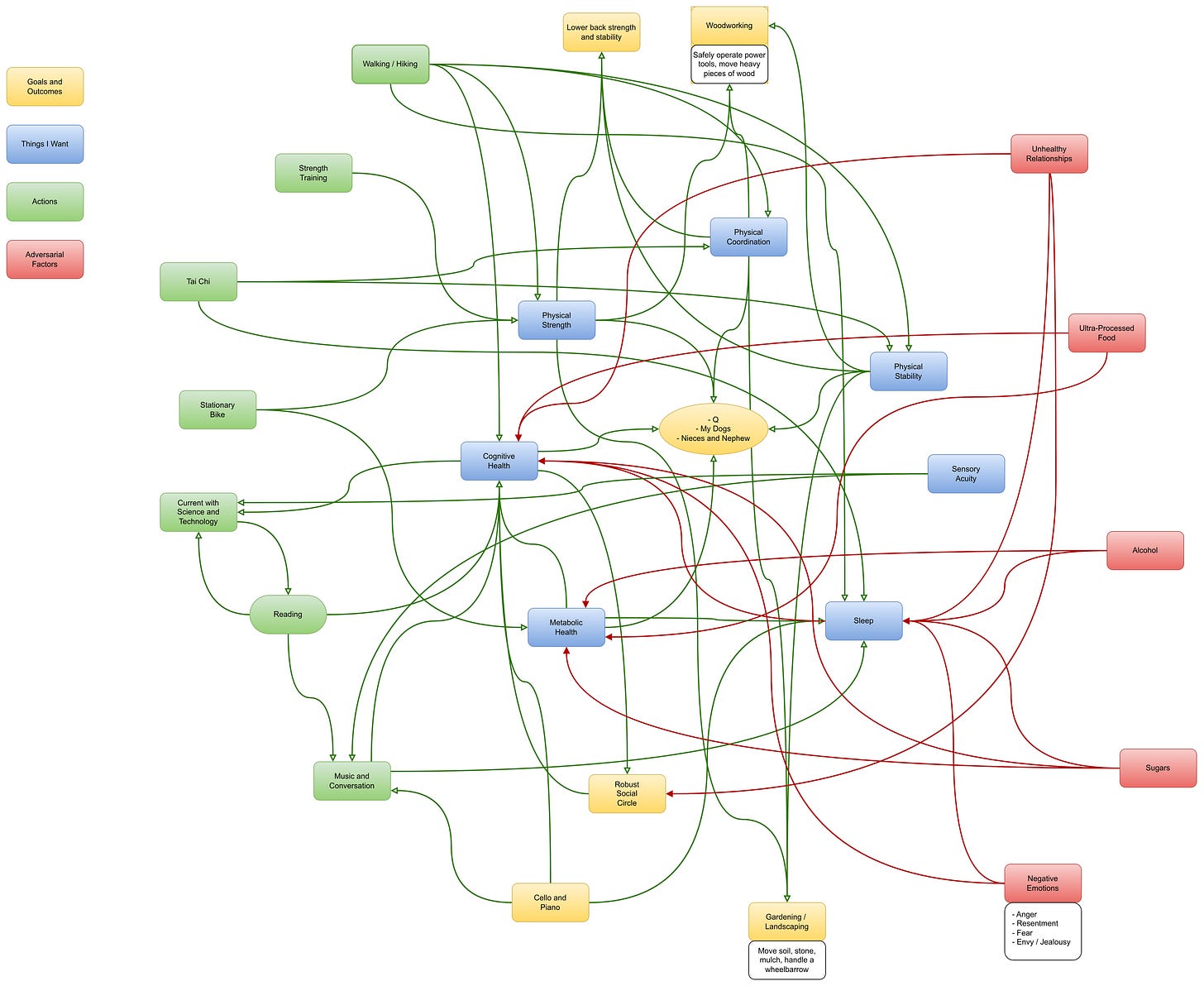Health and Well-being - Part 3 - Goals
A description of the goal is not a strategy." - Richard P. Rumelt
[NB: The Health and Well-being series of articles are reworked and updated from a similar series that first appeared on The Stoic Agilist. My goal for this series of articles is to serve as an example of how anyone might go about improving and sustaining their health and well-being.]
Imagine two large cargo ships that leave Tokyo Bay early one morning bound for Los Angeles. On one ship, the "Aoi Kumo," the captain has carefully plotted a course for his destination. He has the latest data on weather conditions and marine traffic and receives updates every hour. On the other ship, the "Kōkai," the captain prepared similarly for his voyage. Four weeks later, the Aoi Kumo glides safely into the port of Los Angeles. The Kōkai, however, made landfall somewhere off the coast of Oregon, surprising the captain and causing him to make drastic changes in direction with a ship that needs more than a mile to turn. Sadly, the Kōkai ran aground. (All on board were saved and the cargo arrived at it's destination through various means several months late.)
What happened? The captain of the Aoi Kumo knew if he wanted a smooth voyage, he would need to keep his destination in mind and make numerous small adjustments and course corrections throughout the journey. The captain of the Kōkai, however, trusted the original settings and did nothing to respond to external factors that incrementally and imperceptibly nudged his ship off course. As a consequence, his voyage ended in disaster.
The Early Medical program begins by helping participants work out their lifestyle goals for the last decade of life - their near-end-of-life port. Dr. Attia calls this our "marginal decade." Statistically, American women have a life expectancy of 80 years. Men can expect to live to the age of 75, marking a marginal decade that, for me, begins at age 65. Regardless of age, the purpose of working on goals for our marginal decade is to provide a benchmark from which we can begin to work backward to the age we are now and determine what needs to change today so that when we arrive at our marginal decade, our health will support the lifestyle we envision. This is called "backcasting."
A few of the exercises in the Early Medical goals module, while interesting, weren't particularly impactful or insightful. I don't have children and I'm 60+ years old, so the list of people for whom I wish to live a long life is short. The list includes Q, of course, a few nieces and nephews, and my dogs. I derived the most value from the marginal decade exercise. Since I'm statistically about to enter my marginal decade, this exercise was relatively easy. Not just because of immediacy, but also because I've lived a minimalist lifestyle all my life. Perhaps more importantly, it's the accumulated life experiences that inform what I'm interested in and what I'm capable of achieving once I decide to do something.
But you know what they say about statistics. It's one of the three categories of lies (along with plain ol' lies and damn lies.) I have different plans from what Mr. Statistics has in mind. I'm reaching for an extra decade. At least. I'm planning for a marginal decade that begins at 75 and reaches until 85 years of age.
For this exercise, I found the user story format from Agile methodologies helpful in shaking out what a set of minimum viable goals for my marginal decade might be. A few examples...
As an 85 year old male, I want to be capable of hiking to the top of the mesa (alt. 6,500 ft, gain 500 ft) such that I am not out of breath.
As an 85 year old male, I want to be capable of playing piano and cello so that I, my family, and friend enjoy the sound of the music I play.
As an 85 year old male, I want to be capable of defending myself and my family so that we can move about in the world without fear of others.
As an 85 year old male, I want to be capable of standing up unassisted from a seated position on the floor such that my health makes this task effortless and pain-free.
I generated a list of over 70 such marginal decade stories, many of them are sub-stories to more expansive stories. For example, playing piano and cello is a sub-story related to a story about continuing to move toward mastery with several specific interests. Each of these are related to a meta story about maintaining cognitive abilities. Sub-stories might also be related to two or more higher level stories. Playing piano and cello, for example, is associated with mastery in several interests as well as healthy vision and hearing. (See Figure 1 for a sample causal loop diagram illustrating the relationships between a few of these stories.)
If you’ve found something of value in this article, rather than a paid subscription I’d gladly welcome a cup of coffee.
A second technique that proved helpful was the WOOP goal-setting strategy.
Wish: Set a challenging, realistic, and attainable goal.
Outcome: Imagine what it would look and feel like to have your goal fulfilled.
Obstacle: Imagine an obstacle that you can control, such as thoughts, feelings, bad habits, diet, exercise, or other actions.
Plan: Work out a plan to overcome or resolve the obstacles.
WOOP helped not only in defining my goals, but also for shaking out many of the tasks needed to make them a reality. Overall, I've found WOOP more helpful than methods like "SMART" goals. Probably because it seems to be more grounded in scientific evidence related to mental contrasting and if-then planning.[1]
After working through this exercise, several things about the majority of my marginal decade stories became apparent.
They are driven by intrinsic motivation
They don't have deadlines. I can take my time with them, enjoying the journey, and let them unfold in (hopefully) surprising ways.
They presuppose levels of physical and cognitive health and suggest a wide variety of tasks and behaviors I need to focus on going forward. For example, standing up unassisted from a seated position on the floor (something I can do today, hands-free, with ease) presupposes I have the strength, stability, and coordination to complete this task effortlessly. Therefore, given the constraints of aging, I'll need to sharpen my focus on developing these three areas of physical health.
Most of my marginal decade stories aren't the sort of stories I'd put on a Kanban board. They're more akin to epics - broadly stated objectives which I expect to be composed of a lot of actionable tasks. They are objectives around which I plan to organize more detailed work that will be coordinated on a Kanban board.
To round out the idea of goals, there is an additional goal that is more near-term: To reduce all the detailed analysis and tracking described in this series of articles to the level of minimal routine and monitoring. I do, after all, have a life to live.
I worked up version one of this diagram using a whiteboard with sticky notes. It's too easy to overthink things like this, so I time boxed the task to 30 minutes. I spent perhaps another hour creating the diagram in drawio where I refined it a little. I've already tuned this diagram based on subsequent work, but this version should illustrate what you need to do if your plan is to create something like this. (For help on how to read this diagram, see my article on The Remnant's Way: "Master Systems Thinking")
The principle value in working to create causal loop diagrams it that they reveal the relationships between things. For example, the number of things that tie into sleep and cognitive health illustrate the need to focus on developing behaviors that support each of these. Not that the other things are unimportant. I put them on my list of goals, after all. Rather it's clear I will need to emphasize changes that build healthy sleep and cognition.
Disclaimer
The author is not a licensed practitioner of medicine or psychotherapy and nothing presented on this website claims or should be construed to provide medical or psychotherapeutic advice. This series of articles is presented as a personal reflection by the author on work he's done to improve his health and as such is relevant to the author and no one else. The author makes no recommendations as to any course of action the reader may chose to follow other than to encourage the reader to work closely with qualified health professionals when making healthcare decisions relevant to their personal lives.
Footnotes
For more information, search for "Implementation Intention and Action Planning Interventions" in the research literature.
← Health and Well-being - Part 2 - The Table of Contents to Your Owner's Manual
"Health and Well-being - Part 3 - Goals" last updated on 2025.08.07.
Health and Well-being: Part 4 - Tools, Skills, and Attitudes →
I hope you will return regularly to The Remnant's Way as I often update posts, particularly Ab Initio, and do not always publish to email posts that are meant to support or serve as reference to existing or future posts.
And please consider becoming a paid subscriber. Doing so supports my writing efforts and grants me the most precious of all resources - dedicated time for writing. And for that, I am deeply grateful. If you prefer, buy me a cup of coffee if there is an article here and there that you enjoyed or found valuable.
Image by Peggy und Marco Lachmann-Anke from Pixabay
Image by Peggy und Marco Lachmann-Anke from Pixabay
Image by DreamDigitalArtist from Pixabay
Image by DreamDigitalArtist from Pixabay



